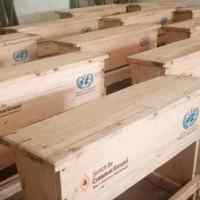The herders continue walking, looking for green pastures. Their cattle are skinny and thirsty. Prolonged hot temperatures have dried up the natural wells and turned the fields dry. The herders cross the porous border from Chad, Sudan, and Cameroon into the Central African Republic, as they have always done, but now they have to walk further. Climate change and conflict have complicated traditional ways.
Herders used to follow ancestral grazing routes, which respected the farmers’ land adjacent to them. As climate change caused herders to push farther into the Central African Republic, the cattle encroached upon the farmers’ fields, destroying crops and depleting the farming communities’ water supply. Climate change has also increased the number of herders crossing into the Central African Republic, making them come at unpredictable times as rogue weather patterns upset growing seasons.
The Central African Republic has been an independent country for a little more than 60 years. Most development and infrastructure investment has been made in urban areas, leaving a need for more government oversight in rural areas. In lieu of a legal system, elders from the herding and farming communities would settle disputes between herders and farmers.
Over the last ten years, the power of the elders has been usurped by armed, non-state actors. After the 2013 coup which overthrew the Central African Republic’s government, armed, non-state actors started robbing the herders as they searched for fertile fields. In turn, the herders armed themselves, increasing the number of weapons in the region. Disputes between herders and farmers became violent as mistrust, resentment, and a desire for retaliation increased in both communities.
Working with youth leaders, we run a conflict prevention project in the Bamingui -Bangoran region in northern Central African Republic. This rural area, a two-day drive from the capital city of Bangui, has had almost no infrastructure investment– no paved roads, no running water, and no electricity. Some villages have small solar panels, where families can charge a cell phone or a lantern. People survive on subsistence agricultural farming. The lack of road infrastructure limits trading, the development of markets and livelihoods, and access to education.
Working through our Common Ground Approach, we invited community leaders from the herder and farming communities to participate in trust-building workshops and to strengthen their mediation skills. We ensure youth (age 17 to 35) community leaders were invited so they would have a voice in the process because a plurality of voices in decision-making yields the most sustainable results.
Within the Common Ground Approach, community leaders identify a goal all parties in conflict want to accomplish and work together to reach it. The children of the herders and farmers attend the same school, so the community leaders from both groups found common ground in rehabilitating the local school. After the building was refurbished, we also provided desk sets so the students would have a place to sit and learn.
When we talk about the impact our programming makes, it’s easy to confuse outputs with outcomes. Outputs are easy to measure. We rehabilitated a school and brought in 50 desks to benefit 150 students. Outcomes are harder to count because they are often intangible and occur over the long run. Besides the obvious impact having a desk and somewhere to sit makes on learning, what’s harder to measure is how access to education helps keep young people from joining armed, non-state armed groups, but it does because education gives them purpose and possibility. When the children from these at-odds communities learn together, they realize they have more in common than previously thought.
The students experience the immediate impact of the project, but their parents are affected too. Throughout this 22-month project, the farmer and herder communities learned how to work together. They organize joint activities without our prompting because they recognize how important the school is to their community’s development. This is a real breakthrough, essential for peace to take root and hold. They have learned to trust one another and will continue to deepen that trust as they work together to maintain the school. They are joint stewards of the school, sharing collective responsibility and slowly undoing patterns of violence.
Get Kids Back on Track this School Year!


